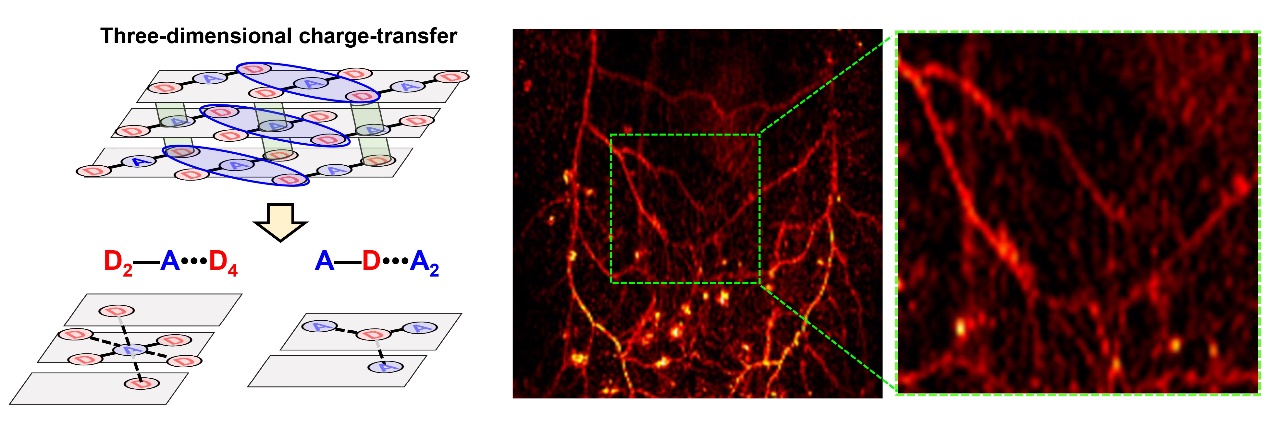
Raman spectroscopy is widely used in chemical analysis, material sciences, and biomedical research due to its high specificity and fingerprint spectroscopy. Spontaneous Raman imaging of small molecules is often insensitive, with Raman scattering occurring in only 1 in 10 million incident photons. As a result, the spontaneous Raman imaging signal of small molecules is extremely weak and difficult to detect. To enhance the signal intensity, current strategies rely primarily on surface-enhanced Raman scattering (SERS) techniques, which amplify the Raman signal intensity by coating small Raman active molecules on metal-based materials such as gold and silver. However, there are biosafety issues of these substrate materials, which have been a long-lasting bottleneck restricting the application to live Raman spectral imaging and clinical translation.
Prof. Wei Lu from Fudan University School of Pharmacy in collaboration with Prof. Zeyu Xiao from Shanghai JiaoTong University School of Medicine and Prof. Xiaohong Fang from Chinese Academy of Sciences Hangzhou Institute of Medicine, discovered a class of small molecules with specific structures that can significantly enhance the Raman signal without relying on the substrate materials. These small molecules have an electron-donor-acceptor-donor (D-A-D) structure, planar conformation and in-plane multi-ring vibration characteristics, showing good intramolecular charge transfer capability. More importantly, they are able to stack each other to form a spatial arrangement with close D-A distances between molecules, thus facilitating intermolecular charge transfer between adjacent molecules in both in-plane and out-of-plane directions. This three-dimensional “supramolecular” D-A structure significantly enhances the effect of charge transfer on enhanced Raman scattering. Based on this phenomenon, the research team proposed a new Raman scattering enhancement mechanism, referred to as Stack-Induced Charge Transfer-Enhanced Raman Scattering (SICTERS).
Furthermore, the research team prepared SICTERS-based probes that improved the Raman scattering cross section of each particle by 1350-fold compared to conventional gold SERS probes with the same particle size. SICTERS outperformed SERS in terms of in vivo imaging sensitivity, spatial resolution, and depth, and enabled intraoperative microtumor detection. SICTERS enabled high-resolution, non-invasive transdermal imaging of lymphatic drainage and blood vessels, which was not achieved with SERS. In addition, SICTERS-based probes had good pharmacokinetic properties, avoiding the biosafety issues of SERS-based probes. This study provides a new principle for the design of biosafe and highly sensitive Raman image probes that promote the in vivo biomedical application of Raman image technology.
The work entitled “Self-stacked small molecules for ultrasensitive, substrate-free Raman imaging in vivo” has been published in Nature Biotechnology online. Meanwhile, Nature Biotechnology has published a Research Briefing entitled “Small molecules self-organized in an orderly manner to enhance Raman signals”, which highlighted the work from the aspects of challenges in the research field, scientific discoveries, and future directions.
Dr. Shuai Gao from Fudan University School of Pharmacy, Dr. Yongming Zhang and Assistant Prof. Kai Cui from Shanghai JiaoTong University School of Medicine are the co-first authors of the research article. Profs. Wei Lu, Zeyu Xiao and Xiaohong Fang are the corresponding authors. This work is supported by grants from the National Natural Science Foundation of China, National Key R&D Program of China, Science and Technology Commission of Shanghai Municipality, and Shanghai Municipal Health Commission.
Shuai Gao#, Yongming Zhang#, Kai Cui#, Sihang Zhang, Yuanyuan Qiu, Yunhui Liao, Haoze Wang, Sheng Yu, Liyang Ma, Hongzhuan Chen, Minbiao Ji, Xiaohong Fang*, Wei Lu*, Zeyu Xiao*. Self-stacked small molecules for ultrasensitive, substrate-free Raman imaging in vivo. Nature Biotechnology 2024; doi.org/10.1038/s41587-024-02342-9.
Web link: https://www.nature.com/articles/s41587-024-02342-9
